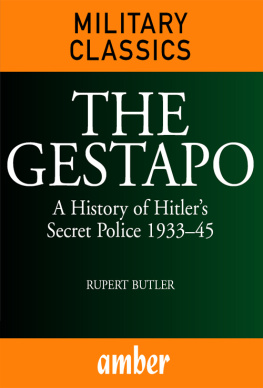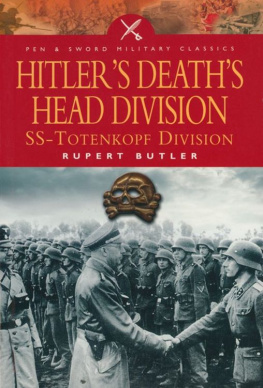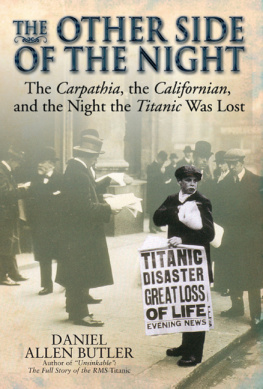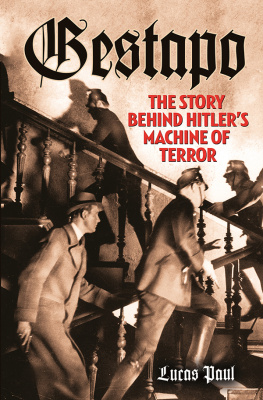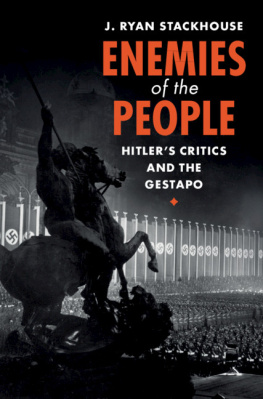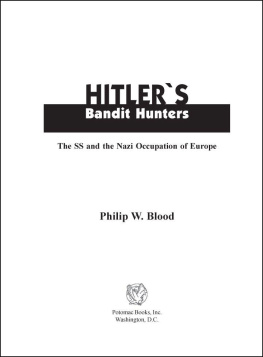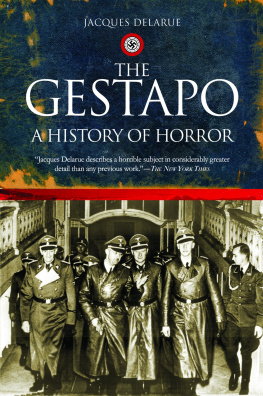THE
GESTAPO
A History of Hitlers
Secret Police 193345
RUPERT BUTLER

This digital edition first published in 2012
Published by
Amber Books Ltd
Bradleys Close
7477 White Lion Street
London N1 9PF
United Kingdom
Website: www.amberbooks.co.uk
Appstore: itunes.com/apps/amberbooksltd
Facebook: www.facebook.com/amberbooks
Twitter: @amberbooks
Copyright 2012 Amber Books Ltd
ISBN: 978 190 827394 9
All rights reserved. With the exception of quoting brief passages for the purpose of review no part of this publication may be reproduced without prior written permission from the publisher. The information in this book is true and complete to the best of our knowledge. All recommendations are made without any guarantee on the part of the author or publisher, who also disclaim any liability incurred in connection with the use of this data or specific details.

www.amberbooks.co.uk
Contents
Other titles in this series:
The Battle of Britain
The Battle of the Bulge
Bodies of Evidence
Churchill: A History
The History of Torture
The Marine Corps
The Sniper At War
SS: Hitlers Foreign Divisions
Stalingrad 19421943: The Infernal Cauldron
The Survival Handbook
The Vietnam War
The Worlds Great Tanks

Website: www.amberbooks.co.uk
Appstore: itunes.com/apps/amberbooksltd
Facebook: www.facebook.com/amberbooks/
Twitter: @amberbooks
CHAPTER 1
FOUNDATIONS
German defeat in World War I heralded the Weimar Republic, a regime soured with cynicism and breeding violence in the streets. But with the advent of Hitler came the hope of a new dawn.
Even though the Gestapo, as the Secret State Police dedicated to maintaining the National Socialist regime, perished along with Nazism in 1945, much of its influence and power survived until the collapse of Communism. Five years after the end of World War II, the infamous Ministerium fr Staatssicherheit (Stasi) was established in East Germany, using methods that were only too familiar to many Germans: controlled media, a vast network of informants to repress subversives, the encouragement of family members to spy on one another through physical threats and the fear of blackmail. By the late 1980s, the Stasi, which maintained a force of more than 90,000 uniformed and plain-clothed agents, had around 175,000 official informants on its books roughly one for every hundred people. Many of its most experienced early operatives were former Gestapo members.
The existence of the Stasi was a reminder, although an extreme one, that all governments, of whatever complexion, rely on some form of covert law enforcement, using various measures to uncover possible conspiracies against the state and perceived threats to civil order. The more authoritarian the government concerned, the harsher are likely to be its methods.
Members of the Ochrana, for example, as the servants of Imperial Russian autocracy, carried out mass arrests and torture against political opponents between 1881 and 1917. Following the 1917 October Revolution, they were succeeded by the Cheka (the Extraordinary Committee Against Sabotage and Counter Revolution), which took over many of the characteristics of its tsarist predecessor, using penetration agents and agents provocateurs. The organizations later introduced by the Communists, the Soviet Military Intelligence (OGPU) and the Committee of State Security (KGB), had a broad network of special departments to probe the armed forces, industry and all major government institutions. As in all dictatorships, their agents recruited a large number of informers whose task was to ensure the observance of security regulations and to monitor the activities of employees. All relied to different degrees on terror and intimidation. No one knows precisely how many people were sent to camps during the era of Stalins purges, but it has been estimated that between four and five million people were detained before and after World War II.
The first sophisticated methods of covert law enforcement by Germany were modelled on the achievements of Napoleon Bonaparte, who had organized espionage as an integral part of his military system of operations. Karl Stieber from Saxony, a former barrister and Socialist turncoat, worked undercover at the behest of the King of Prussia. He gained the post of Polizeirath , which rendered him independent of normal police control and equipped with the tools to create a comprehensive intelligence system the agents of which rooted out enemies of the state. The basis of the system Steiber evolved remained more or less intact until Germanys defeat in 1918.
THE OLD ORDER
The Weimar Republic between the two world wars was characterized by shifting political loyalties underpinned by a surge in street violence. Although there was an official ban on an all-German secret police apparatus, one had been established in Berlin nevertheless, with steadily creeping powers to prevent and prosecute all penal offences that have a political character. Thus there were already a power base and personnel to run the Gestapo when it was founded in Prussia. Until then it had been subject to the rule of civil law, but this state of affairs was soon to change.
The death throes of Weimar had long been obvious to alarmed observers outside Germany, but it was not until 30 January 1933, when President and Generalfeldmarschall Paul von Beneckendorf und von Hindenburg, the aged icon of the old order, met with Adolf Hitler, the Austrian rabble-rousing populist of the National Socialist Workers Party (NSDAP), that the fate of the world for the succeeding 15 years was finally decided. Hitler assumed the title of Reich Chancellor despite von Hindenburgs earlier contemptuous declaration that the Austrian corporal was barely fit to be minister of post.
THE WEIMAR REPUBLIC
The Weimar Republic, which emerged from the ashes of German defeat in 1919 and lasted until the birth of the Third Reich in 1933, was named after the town, 240 km (150 miles) southwest of Berlin, where the signatories of a national assembly had accepted the Versailles Treaty. This required Germany to reduce its territory and to disarm, even though the army and civil service were retained.
It had been intended that the Constitution of the new Republic should take as its model the achievements of long-established democracies the form of cabinet government existing in Britain and France, the election of a president along American lines and, where appropriate, the employment of referenda, as in Switzerland. This was to be expressed in fine phrases that seemed irreproachable: Political power emanates from the people All Germans are equal before the law All inhabitants of the Reich enjoy complete liberty of belief and conscience.
But these high aspirations were overshadowed by the Versailles Treaty, which was anathema to both the army and to conservative politicians, who refused to accept it as a treaty of peace or the Republic that ratified it. Opposition to Weimar hardened further when the Mark plunged, heralding disastrous inflation and making German currency worthless. A plea by Germany to suspend moratorium payments was rejected and French troops occupied the Ruhr, effectively tearing the heart out of the countrys economy. The masses of the people, saddled with a useless currency, turned their wrath on the architects of the Weimar Republic, much of it manifest in street violence.

